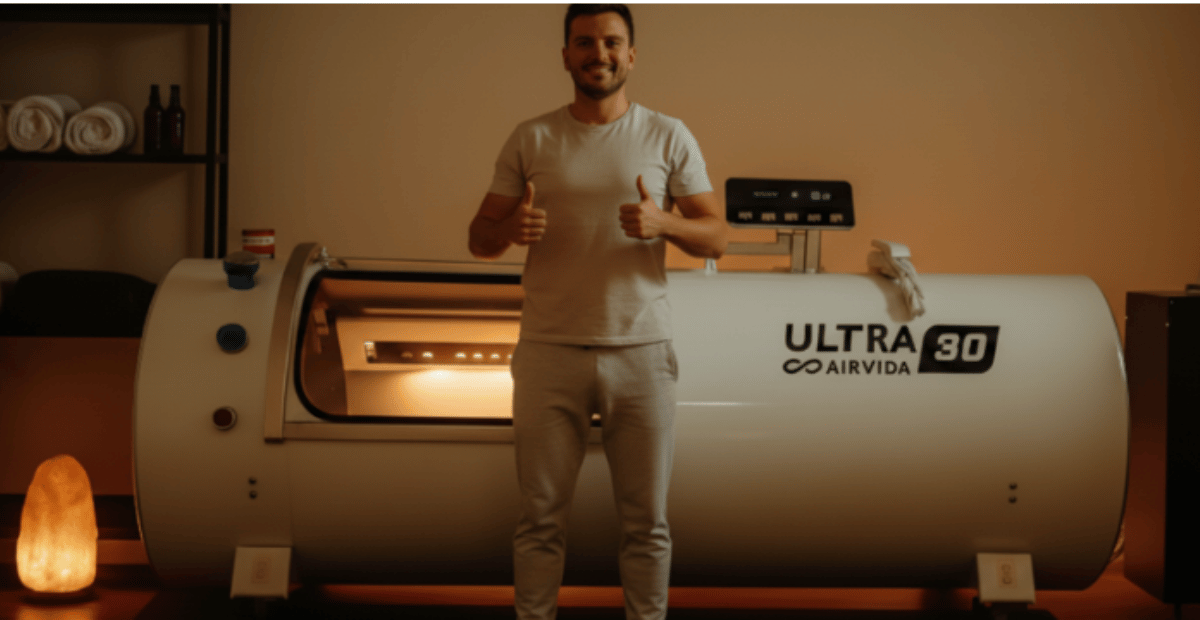ver wondered what is the success rate of hyperbaric treatment and how effective it really is? In general, studies and user reports show that many patients experience improved recovery, reduced inflammation, and faster healing, especially when treatment is applied consistently.
The overall success depends on several factors, such as condition type, treatment frequency, and the quality of the chamber used. Let’s explore why this therapy works, how success is measured, and what you can do to enhance your outcomes.
Understanding Hyperbaric Oxygen Therapy (HBOT)
Hyperbaric Oxygen Therapy (HBOT) involves breathing pure oxygen in a pressurized chamber. This process increases oxygen levels in the blood, accelerating the body’s natural healing response.
When oxygen saturation increases, it stimulates cell repair, reduces swelling, and supports tissue regeneration essential for recovery from injuries, wounds, and even chronic conditions.

HBOT was initially developed to treat decompression sickness in divers but has since evolved into a versatile therapy used for various conditions. Today, it may help patients with carbon monoxide poisoning, chronic non-healing wounds, radiation injuries, certain infections, and even sports-related muscle or tissue damage by promoting oxygen-based recovery and repair.
Why the Success Rate Varies
The success rate of hyperbaric treatment can differ widely depending on what it’s used for. Not all conditions respond equally because each has a unique oxygen demand and healing pathway.
For example, chronic wounds and radiation injuries often show higher success rates than neurological conditions. Below is a simplified view:
Table 1: Typical Reported Success Rates by Condition
|
Condition Type |
Average Reported Success Rate |
Notes |
|
Chronic diabetic wounds |
70–90% |
Significant tissue recovery after multiple sessions |
|
Radiation tissue damage |
65–80% |
Reduces pain and promotes vascular growth |
|
Sports injury recovery |
60–75% |
Accelerates tissue repair and reduces downtime |
|
Post-surgical healing |
55–70% |
Promotes oxygen circulation to incision sites |
|
Traumatic brain injury |
40–60% |
May support neurological improvement with consistent use |
These figures vary based on frequency and chamber type. A high-quality, large-capacity unit like those in our Large Hyperbaric Chamber Collection can improve oxygen saturation levels, allowing more efficient cellular recovery.
How the Treatment Works in the Body
Each HBOT session typically lasts between 60 and 90 minutes at a pressure level ranging from 1.5 to 3.0 ATA. While inside the chamber, the body absorbs oxygen at nearly 20 times the normal rate, which may help promote tissue repair, stimulate healing, reduce inflammation, and support overall recovery.
This helps:
-
Stimulate collagen production: HBOT increases oxygen supply to tissues, which helps activate fibroblast cells responsible for producing collagen that strengthens and repairs skin and connective tissue.
-
Reduce inflammation and swelling: By improving oxygen circulation, HBOT can decrease fluid buildup and suppress inflammatory cytokines, supporting faster healing and reducing tissue pain or discomfort.
-
Fight bacteria and support immune response: High oxygen levels enhance white blood cell activity, making it easier for the immune system to combat infections and prevent bacterial growth in damaged tissues.
-
Promote angiogenesis (new blood vessel growth): HBOT encourages the body to form new capillaries, improving blood flow and oxygen delivery to previously oxygen-deprived or injured areas.
Over time, these effects combine to strengthen recovery, making HBOT particularly useful for athletes and post-operative patients. Curious about its use for athletic recovery? Check out our guide on Hyperbaric Chamber Therapy for Sports Injuries.
Factors That Influence the Success of HBOT
Not everyone experiences the same results from hyperbaric oxygen therapy, and that’s completely normal. Several important variables influence how effectively the body responds, including the individual’s overall health, the condition being treated, therapy duration, chamber pressure levels, and consistency in following the recommended treatment plan.
Table 2: Key Factors Affecting Treatment Outcome
|
Factor |
Influence on Results |
Practical Tip |
|
Treatment frequency |
Higher frequency = better tissue response |
4–5 sessions per week recommended for chronic cases |
|
Chamber size and pressure |
Affects oxygen penetration and comfort |
Larger chambers allow better circulation and movement |
|
Condition type |
Chronic wounds respond faster than neurological cases |
Start with a physician-guided evaluation |
|
Lifestyle and diet |
Poor nutrition may slow repair |
Maintain hydration and balanced meals |
|
Consistency of therapy |
Sporadic use lowers effectiveness |
Follow the full treatment plan as advised |
For users who need flexibility or at-home access, explore our mHBOT Chamber Collection for reliable, user-friendly solutions that fit personal recovery routines.
What Makes HBOT an Appealing Option
Beyond its measurable clinical outcomes, HBOT stands out as a non-invasive and drug-free therapy that complements existing treatments. Many patients also value the calm, meditative atmosphere inside the chamber, often describing each session as both physically restorative and mentally relaxing, contributing to overall wellness and improved treatment satisfaction.
In wound care centers, success rates above 80% are common when combined with antibiotics or surgical care. For more on that, see our article on Hyperbaric Chamber for Wound Care.

Practical Tips for Better Results
To get the most out of your hyperbaric oxygen therapy, a few mindful habits can make a big difference. From staying consistent to maintaining hydration and safety, these practical tips help enhance your overall treatment experience.
1. Follow a full treatment plan:
Skipping sessions can slow healing and delay results. Consistency allows your body to adapt to oxygen-rich therapy, maximizing its full regenerative potential for tissue repair and recovery.
2. Stay hydrated:
Oxygen-rich environments can dehydrate the body faster than usual. Drink plenty of water before and after each session to help maintain balance, enhance circulation, and support natural detoxification.
3. Combine with nutrition and rest:
Recovery accelerates when your body has adequate fuel and downtime. Pairing HBOT with proper diet and restorative sleep helps your cells regenerate more efficiently for improved overall wellness.
4. Use a certified chamber:
Always verify that the chamber meets recognized safety and pressure standards. Certified units ensure consistent oxygen delivery, minimize risks, and provide the best therapeutic experience possible during HBOT sessions.

Key Takeaway
Hyperbaric oxygen therapy shows promising success rates across multiple health applications. While results vary by condition and consistency, many users experience faster recovery, reduced pain, and better tissue repair.
The best outcomes from hyperbaric oxygen therapy come from consistent, well-pressurized sessions conducted in certified chambers under professional supervision. Pairing HBOT with healthy lifestyle habits, balanced nutrition, and regular medical monitoring helps maximize its therapeutic potential while ensuring long-term safety, optimal oxygen absorption, and improved overall wellness results for each patient.
Final Thoughts
So, what is the success rate of hyperbaric treatment? Results typically range from 60% to 90% depending on the condition, equipment, and consistency. HBOT offers a natural way to boost healing and overall wellness.
If you’re ready to experience its benefits firsthand, explore our collection of Large Hyperbaric Chambers or discover portable options in our mHBOT Chamber Collection.
Give your body the oxygen advantage it deserves. 🌿
Frequently Asked Questions: What Is the Success Rate of Hyperbaric Treatment
Why are doctors against hyperbaric oxygen therapy?
Some doctors are cautious about HBOT because it isn’t FDA-approved for every condition, and more large-scale studies are needed. However, HBOT is medically approved for several conditions, like decompression sickness, chronic wounds, and radiation injuries. The skepticism often comes from limited insurance coverage or a lack of familiarity with newer applications.
How long does it take to see results from a hyperbaric oxygen chamber?
The time varies based on your condition. Most patients notice changes after 5–10 sessions, such as improved energy, reduced pain, and better wound healing. Chronic issues like neuropathy or brain injuries may need 20–40 sessions for visible progress. Consistency is the key factor; the more regular your treatments, the stronger the cumulative results.
What is the alternative to a hyperbaric chamber?
Alternatives depend on the purpose of treatment. For example, oxygen concentrators can support mild respiratory issues but don’t offer the same tissue-level oxygenation. For wound healing or neurological recovery, no other non-invasive option matches HBOT’s oxygen delivery. Some combine HBOT with physical therapy, nutrition, and regenerative medicine for enhanced outcomes.
What kind of issues does hyperbaric oxygen fix?
Hyperbaric oxygen therapy helps treat multiple issues, from diabetic ulcers and carbon monoxide poisoning to sports injuries and post-surgical recovery. It’s also being studied for neurological conditions like stroke and traumatic brain injury. HBOT works by increasing blood oxygen levels, which accelerates cell repair, reduces inflammation, and enhances overall recovery efficiency.




